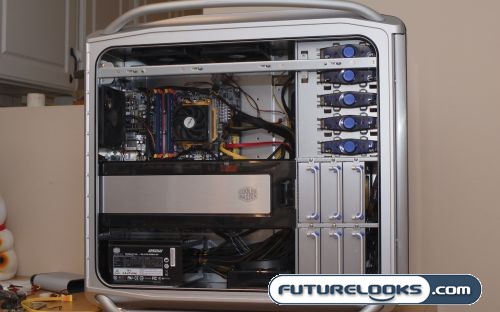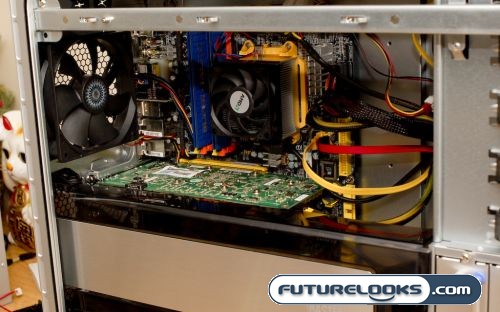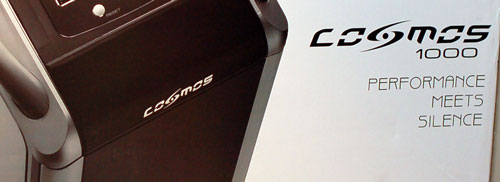The Finished Product

So after all is said and done, the Cooler Master Cosmos 1000 builds up into a very clean looking system. Thanks to the included twist ties and cable management accessories, we were very please with the results.

One thing that you won’t have to worry about with this case is your choice of CPU cooler. The Cosmos has enough room to fit the largest heatsinks as long as your motherboard doesn’t get in the way. The stock AMD heatsink that we originally had in there looks absolutely tiny compared to the cavernous enclosure surrounding it. The Thermaltake V1 Cooler that we used in our performance tests fit beautifully with no problems whatsoever.
Performance
After admiring our build for far too long, we were eager to take some readings to see if this computer case would back up its show with some go. Afterall, it doesn’t matter how good a case looks if its noisy and cooks your gear inside. No testing was done until we had a chance to cook all our components in the case for at least 24 hrs to make sure that our build was stable and that the heatsink compounds were able to provide maximum thermal conduction properties.
Our idle conditions were established by booting into Windows Vista from a cold start and then letting the system warm up on its own for one hour. After it was warmed up, we heated things up by running 3DMark06 in a looping demo for another hour. We took temperatures and noise level readings at both idle and load conditions. Noise level readings were taken using a sound level meter pointed six inches away from each of the case and CPU and System temperatures were monitored using ITE System Monitor.
Noise Levels (dBA) – Idle
- Top: 40 Left: 41 Right: 41 Front: 45 Rear: 45
Noise Levels (dBA) – Load
- Top: 43 Left: 48 Right: 53 Front: 48 Rear: 50
Sitting beside the system with it placed under a desk, you definitely know that the system is running, but it isn’t whiny or annoying. It makes a sound that is more of a low dull roar than anything else. Under load conditions, we see a definite increase in noise level according to the noise level meter. This extra noise seemed to be coming from the two 8800 Ultra Video Cards stuffed in the Cosmos 1000. Under load, you definitely know that it is running, but with your gaming headset on, I don’t think you would care anyway. Folks not running these notoriously hot video cards should be rewarded with a reciprocal decrease in noise.
Temperature (Celsius) – Idle
- CPU Temperature: 46 C / System Temperature: 43 C
Temperature (Celsius) – Load
- CPU Temperature: 57 C / System Temperature: 49 C
The temperature increases were definitely acceptable across the board and there weren’t any wild temperature fluctuations to report. The system temperature of the Northbridge was well within acceptable limits underload as well. Since I had been able to run the system for a few weeks, I did notice a peculiar temperature related problem with the VGA duct. At the end of the duct near the back of the case, there is a filter panel. After running the system through a few weeks of gaming sessions, I noticed that this filter panel had actually warped from the heat generated from the two 8800 Ultras. I actually pulled the VGA duct off and noticed that the GPU temperature dropped immediately by a couple degrees under load. Granted, the VGA duct does look cool, but it isn’t from a temperature standpoint.
Real-Time Price and Stock Check – Shop Like a PRO!

